The Golden Dawn or Thoth Method

Difficulty: Complicated
Note: Tarot decks that use reversed cards such as the Rider-Waite do not work well with this spread, which was designed to be read using elemental dignity.
The Golden Dawn spread is best suited for use with the bifrost Tarot and especially the Book of Thoth, as these decks are meant to be read a certain way with the court cards. Princes and queens represent actual men and women connected with the matter, while princesses generally represent ideas; thoughts or opinions, and knights represent arrival or departure of a matter depending on the direction faced.
In this tarot spread, particular attention should be paid to a card's exact position in relation to its neighbours. Whether the neighbour cards bear the same energy (suit) determines whether a card is considered well-dignified or ill-dignified. Opposite suits ill-dignify each other, while other suits are considered friendly. Tarot cards of the same suit or element strengthen each other.
As with other tarot spreads, it is important to count the cards' tendencies, such as whether there is a lot of one particular suit or number pattern. The patterns reveal special messages. Having several majors present indicates higher forces at work, several cups suggest strong emotions, etc.
Card #1 represents the reader and the nature of the topic at hand.
Cards #2 & #3 are read in extension of #1 to further comprehend the nature of the topic.
The two sets of three tarot cards at the top of the spread represent chronological sets of events. The current path as it would unfold naturally is represented by cards #4, #8, & #12. The alternate path that could be taken is represented by cards #13, #9, & #5. However, if the reader gets the feeling these cards are telling them they go together, then the alternate path is to be considered an extension of the current path, and to be read chronologically in this order: #4, #8, #12, #13, #9, #5. Just keep in mind: this is only if the two paths seem particularly similar.
Cards #14, #10, & #6 shed light upon the psychological undertones of the current issue.
Cards #7, #11, & #15 represent the influences of karma and destiny beyond the reader's control. These cards suggest adapting to this, as fate.
Your Golden Dawn Reading
| The Alternate Path (or Extension of Current Path) |
Your Current Path |
|||||
II – The Priestess |
XI – Lust |
XXI – The Universe |
IX – The Hermit |
IV – The Emperor |
0 – The Fool |
|
| The Querent | ||||||
V – The Hierophant |
XX – The Aeon |
XV – The Devil |
||||
| The Psychological Basis | Karma | |||||
XIX – The Sun |
VIII – Adjustment |
VI – The Lovers |
I – The Magus |
VII – The Chariot |
XII – The Hanged Man |
|
The Querent
cards represent the querent and the nature of the topic at hand. The first card (in the center of the spread) represents the very core of the matter, and the other two cards around it are added to it in order to further comprehend the nature of the topic.

(Judgement, Fire, Shin)
The Aeon represents transformation, evolution, and the awakening to a higher state of consciousness. Associated with Shin, the tooth, this card reflects the process of breaking through old paradigms to embrace a new spiritual era. Crowley's reinterpretation of Judgement as The Aeon emphasises rebirth on a cosmic scale, rather than individual reckoning.
The central figure is the translucent child-god Horus, representing the dawn of a new age. Above him, Nuit, the goddess of infinite space, arches across the sky, and Hadit, the fiery point of divine inspiration, burns at her core. The two incarnations of the same figure symbolise the transition from the old to the new. The vibrant reds and blues throughout the card evoke the dynamic forces of destruction and creation.
In Relationships: The Aeon signifies the potential for profound change. It suggests leaving behind outdated patterns and embracing a higher level of connection and understanding.
In Work: This card indicates a turning point, calling you to align with your true purpose and embrace transformative opportunities.
Spiritually: The Aeon symbolises awakening to a higher state of being. It calls you to release the past and step into your divine purpose with courage and clarity.
When ill-dignified: The Aeon warns of resistance to change, clinging to outdated beliefs, or fear of transformation. You are advised to trust the process of renewal and embrace the potential of the new era.
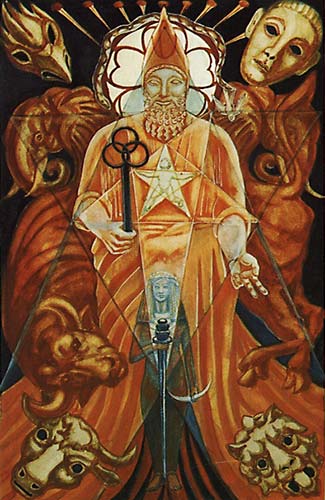
(Taurus, Vav)
The Hierophant is a figure of sacred knowledge and spiritual authority, acting as the bridge between the divine and the mundane. Linked to Vav, the nail, he unites opposing forces and secures the sacred connection between heaven and earth. Taurus, the zodiac sign of stability and sensuality, lends him an enduring, earthy strength.
The Hierophant is depicted as a commanding figure robed in red, symbolising spiritual power and divine authority. He stands as a bridge between the divine and material realms. A large pentagram glows on his chest, signifying mastery over the elements and sacred knowledge. He holds a three-ringed sceptre, representing dominion over body, mind, and spirit. The Egyptian priestess beneath him suggests hidden wisdom or esoteric teachings. Surrounding him are symbolic beasts—the bull of Taurus, an elephant, and four cherub masks—reinforcing themes of strength, structure, and initiation into higher knowledge. The composition conveys mystical revelation, initiation, and the channelling of sacred truths.
In Relationships: The Hierophant suggests relationships guided by shared values, spiritual connection, and mutual growth. It emphasises the importance of trust, commitment, and alignment in beliefs.
In Work: This card speaks to mentorship, tradition, and the power of established systems. It advises you to seek wisdom from trusted sources and honour the tried-and-true methods that lead to success.
Spiritually: The Hierophant represents initiation into higher knowledge and the sacred mysteries. He invites you to seek wisdom from spiritual teachings and align your actions with divine will.
When ill-dignified: The Hierophant warns against dogmatism, blind adherence to tradition, or excessive reliance on external authority. You are advised to discern whether you are following your spiritual truth or conforming to others' expectations.
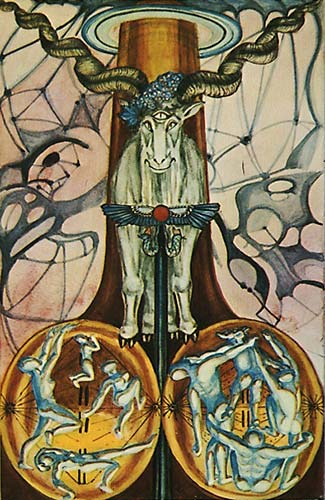
(Capricorn, Ayin)
The Devil symbolises bondage, materialism, and the potent, often misunderstood forces of desire and instinct. Associated with Ayin, the eye, this card invites a piercing vision into the illusions and structures that bind us. Capricorn, the zodiac of ambition and discipline, infuses the card with themes of mastery over material and earthly limitations.
The central figure is a goat before a phallic structure, symbolising generative power and material dominance. This card is seething with esoteric symbols of competition within a person. The background, webbed in deep, earthy tones, suggests the shadowy nature of the forces at play. The card is alive with energy, hinting at temptation and the potential for liberation.
In Relationships: The Devil represents intense, often obsessive attraction. It can warn of relationships rooted in control or dependency, urging you to assess whether your connections are serving your growth.
In Work: This card suggests material success, often achieved through relentless ambition. However, it warns of becoming enslaved by wealth or status and advises balancing ambition with higher values.
Spiritually: The Devil symbolises the necessity of confronting and integrating one's shadow self. It calls you to transcend material attachments and awaken to higher truths.
When ill-dignified: The Devil warns of oppression, excessive materialism, or destructive desires. You are advised to liberate yourself by recognising and overcoming illusions and self-imposed limitations.
Your Current Path
cards represent your current path as it would unfold naturally. These cards are read in chronological order from left to right.
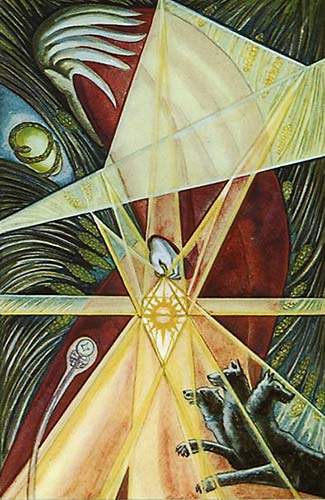
(Virgo, Yod)
The Hermit represents the seeker of inner truth and the wisdom gained through solitude and introspection. Associated with Yod, the hand, this card embodies the divine spark of creation and the active quest for enlightenment. Virgo, the zodiac of analysis and service, lends the Hermit its meticulous and introspective energy.
The Hermit is a lone figure cloaked in red, symbolising both the concealment and revelation of profound mysteries. He holds a glowing lantern containing a star, representing the union of opposites and the illumination of divine wisdom. A serpent coils around the cosmic egg, an emblem of transformation and esoteric knowledge. In the foreground, a radiant yellow glow symbolises enlightenment, while the crop around him suggests the fertile soil of the unconscious mind.
In Relationships: The Hermit suggests introspection or solitude. It encourages you to seek clarity and the understanding of your own needs before reengaging with others.
In Work: This card indicates the value of independent effort and the importance of inner guidance. You are encouraged to trust your own wisdom and focus on long-term goals rather than immediate results.
Spiritually: The Hermit represents the solitary journey of self-discovery and pursuit of higher knowledge. It calls you to turn inward and seek truth through meditation and reflection.
When ill-dignified: The Hermit warns of isolation, excessive withdrawal, or a reluctance to share one's insights. You are advised to balance your introspection with meaningful connection and ensure you are not avoiding life's responsibilities.
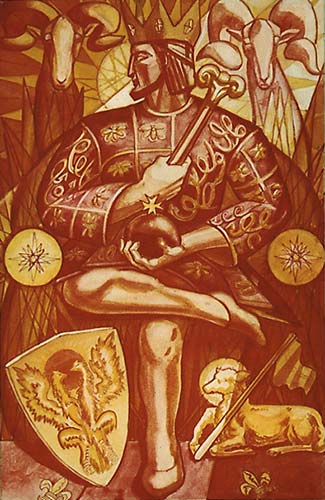
(Aries, Tzaddi)
The Emperor represents the force of order, authority, and structure, embodying the disciplined energy required to manifest power and stability in the material world. He is linked to Tzaddi, symbolising insight and vision, representing the ability to perceive higher truths and take decisive action in alignment with divine will. As the astrological ruler Aries, he brings fiery determination and a pioneering spirit.
The Emperor sits on a ram-adorned throne, a clear nod to Aries, surrounded by a vibrant red background that speaks of his dynamic energy and martial authority. His sceptre, along with the orb and cross, symbolises the dominion of spirit over matter. At his feet lies the double eagle shield, representing far-reaching vision and the ability to soar above obstacles. The geometric forms surrounding him suggest the stability of order, while the lamb beneath his throne reminds us of the balance between power and protection.
In Relationships: The Emperor indicates a relationship rooted in stability, leadership, and mutual respect. It calls for clarity, honesty, and the willingness to establish healthy boundaries and foundations.
In Work: This card represents mastery over the material realm and the ability to build structures that endure. It encourages you to take charge of your destiny confidently and lead by example.
Spiritually: The Emperor signifies the grounding of spiritual energy into practical action. He calls you to embody your highest ideals in your daily life, manifesting divine will through disciplined effort.
When ill-dignified: The Emperor warns of rigidity, authoritarianism, or a misuse of power. You are cautioned to balance control with flexibility and lead with wisdom rather than dominance.
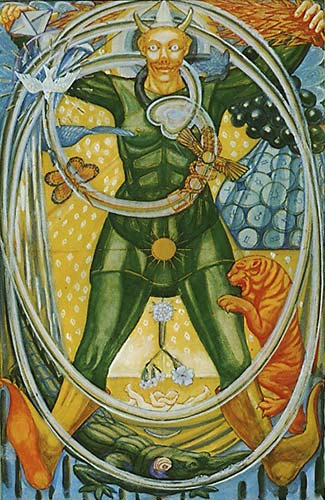
(Air, Uranus, Aleph)
The Fool of the Thoth deck embodies the chaotic, boundless energy of pure potential, untouched by form or limitation. He is the alpha and omega of the journey, the primordial force from which all creation arises. Corresponding to Aleph, the breath of life, and the element of Air, the Fool represents the vibrant, unpredictable nature of Uranus, the planet of sudden change and divine inspiration.
The figure of The Fool is richly adorned, standing amid a swirling maelstrom of symbolic forms. He wears motley robes to represent his openness to all experiences, while the winged sun at his feet symbolises the life-giving power of the divine. Around him whirl a tiger (representing instinct and primal fear), a crocodile (a guardian of the mysteries and a symbol of time), and a rainbow-hued disk, representing the harmony of all elements. The Fool holds a blazing torch in one hand and a crystal cup in the other, signifying the balance of will and receptivity. One foot is grounded in the world, while the other stands on the fourth wall, as if attempting to step into our world.
In Relationships: The Fool represents the potential for new beginnings and uncharted emotional experiences. It encourages you to approach relationships with innocence and trust, unburdened by fears or preconceptions.
In Work: This card advises bold action and faith in one's ideas. It suggests venturing into unfamiliar territory and taking inspired risks, understanding that growth lies in embracing uncertainty.
Spiritually: The Fool symbolises the seeker's initial step on the path to enlightenment, an act of surrender to the cosmic current. It urges you to trust the process and let go of the need for certainty.
When ill-dignified: The Fool warns of chaos, recklessness, or naivety. You are cautioned to discern whether you are pursuing freedom or fleeing responsibility and examine whether your actions align with higher wisdom.
The Alternate Path
cards represent the alternate path that you could choose to take in lieu of the Current Path. However, if the cards that come up seem to indicate that they go along with the Current Path, these three cards should be interpretted not as an Alternate Path, but as a chronological extension of the Current Path (also read from left to right).

(Moon, Gimel)
The Priestess is a figure of serene and inscrutable wisdom, embodying the mysteries of the subconscious and the cycles of the Moon. She corresponds to Gimel, the camel, representing the capacity to traverse vast spiritual deserts and access hidden truths. The Moon's influence lends her an air of receptivity, intuition, and connection to the rhythms of the cosmos.
Seated on her throne, the Priestess holds a bow, an emblem of Artemis and lunar cycles, symbolising her mastery of timing and precision. Her arms mirror the crescent moons of the background, merging her form with the sea of the unconscious. Before her, a tapestry adorned with pomegranates and palms veils the sacred mysteries, separating the seen from the unseen. At her feet lies the crescent moon, a symbol of her dominion over intuition and the waxing and waning cycles of existence.
In Relationships: The Priestess indicates the presence of profound emotional depth and unspoken bonds. It encourages you to trust your intuition and explore the layers of your connection without rushing to conclusions.
In Work: This card suggests the answers lie in reflection and inner knowledge rather than external action. It advises you to trust your instincts and remain patient while the path unfolds.
Spiritually: The Priestess represents the deep well of inner wisdom, the gateway to divine knowledge. She calls you to explore your dreams, meditations, and intuitions for insight into the mysteries of the self and the universe.
When ill-dignified: The Priestess cautions against passivity, confusion, or ignoring intuitive warnings. You are advised to confront hidden fears and distinguish between genuine intuition and projections of the unconscious mind.
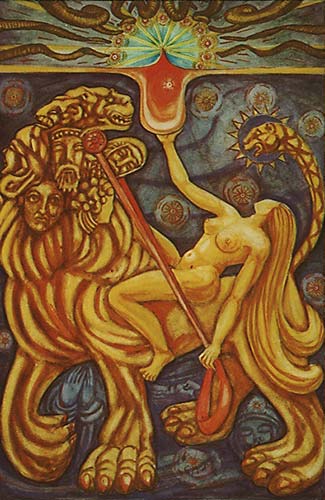
(Leo, Teth)
Lust, known as Strength in many other decks, takes on a unique and profound meaning in the Book of Thoth. This card signifies the ecstatic embrace of life's passions and the power derived from uniting primal instincts with spiritual purpose. Associated with Teth, the serpent, it symbolises both the kundalini energy and the continuous cycles of transformation and renewal. Leo, the zodiac of courage and vitality, infuses the card with boundless confidence and creative expression.
The central figure is a woman riding a multi-headed beast, a symbol of primal forces mastered and directed towards a higher purpose. Her nudity represents authenticity and fearlessness, while the cup she holds aloft is the Holy Grail, symbolising the ultimate spiritual goal. The beast itself, covered in fiery hues, represents the dynamic power of creation, destruction, and renewal. The background is filled with swirling red and gold, reflecting the intensity of life force and divine energy.
In Relationships: Lust represents passion, desire, and a fearless embrace of emotional intensity. It encourages you to fully engage with your relationships, revelling in love's transformative power.
In Work: This card signifies success achieved through boldness, enthusiasm, and a connection to one's creative instincts. You are advised to channel your energy into projects that ignite your passion.
Spiritually: Lust symbolises the awakening of spiritual vitality and integrating one's primal and divine natures. It calls you to surrender to the ecstatic flow of universal energy.
When ill-dignified: Lust warns of unchecked desires, destructive passions, or an overindulgence in material pleasures. You are advised to restore balance and align your desires with a higher purpose.
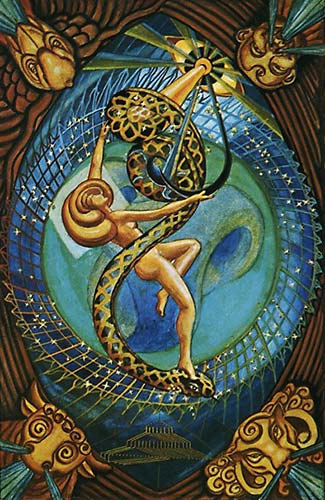
(Saturn, Earth, Tau)
The Universe is the culmination of the journey, symbolising integration, completion, and the harmonious union of opposites. Associated with Tau, the cross, this card reflects the materialisation of divine will and the synthesis of all forces. Saturn, the planet of structure and discipline, anchors the card in themes of order and manifestation.
The central figure is a nude woman, symbolising the perfected self, dancing within a ring of stars, on the head of an enormous serpent. She holds tools of creation in her hands, embodying mastery over all elements. Around her, the four cherubim faces—the lion, the eagle, the man, and the bull—represent the fixed signs of the zodiac and the balance of cosmic forces, as water flows from their noses and mouths. The background represents the infinite possibilities of the universe.
In Relationships: The Universe signifies fulfilment and the realisation of harmony. It encourages you to celebrate the unity and wholeness of your connections.
In Work: This card indicates the successful completion of a cycle and the achievement of long-term goals. You are advised to reflect on your accomplishments and prepare for new horizons.
Spiritually: The Universe symbolises enlightenment, the integration of all aspects of the self, and the realisation of cosmic unity. It calls you to embrace your place within the greater whole and celebrate the infinite potential of existence.
When ill-dignified: The Universe warns of stagnation, fear of completion, or an unwillingness to move forward. You are advised to release resistance and trust in the cycles of growth and transformation.
The Psychological Basis
cards shed light upon the psychological undertones of the current problem.
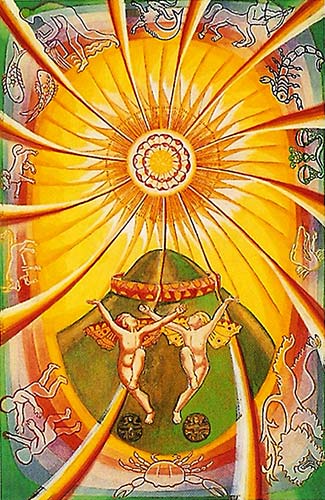
(Sun, Resh)
The Sun radiates with the energy of vitality, clarity, and triumphant renewal. Associated with Resh, the face, this card symbolises self-awareness, illumination, and the expression of the inner light. The Sun, as the central celestial body, embodies life, growth, and divine purpose.
The imagery is vibrant and joyous, as the golden sun blazes in the sky, surrounded by rays of light that fill the scene with warmth and illumination. Beneath it, twin children dance in a fertile landscape, representing innocence, harmony, and the unification of opposites. The background is lush with fields and flowers, a testament to the creative and nurturing power of the sun's energy. The card radiates an undeniable sense of triumph and clarity.
In Relationships: The Sun signifies joy, harmony, and mutual understanding. It brings light to connections, encouraging open communication and the sharing of love without reservation.
In Work: This card represents achievement and the realisation of goals. You are advised to embrace your success and lead confidently.
Spiritually: The Sun symbolises enlightenment, integrating the self, and realising your divine purpose. It calls you to step into your power and radiate your truth confidently.
When ill-dignified: The Sun warns of arrogance, egotism, or overexposure. You are advised to balance your confidence with humility and guard against burning out your energy.

(Libra, Lamed)
In the Thoth deck, the card traditionally known as Justice is renamed Adjustment, reflecting the dynamic nature of balance and the constant recalibration required to maintain harmony. Associated with Lamed, the ox-goad, it represents the guidance and discipline needed to align oneself with universal truth. Libra, the zodiac of balance and fairness, infuses the card with its themes of equity and measured judgement.
The central figure of Adjustment is a serene androgynous figure holding a sword while balancing on their toes, between a balanced pair of scales. The sword symbolises the piercing clarity of truth, while the scales represent the cosmic law of cause and effect. Their poised stance is framed by geometric patterns, emphasising precision and the mathematical order of the universe. Behind them, a brilliant green background evokes the idea of renewal and the living equilibrium of nature.
In Relationships: Adjustment highlights the importance of honesty, fairness, and mutual accountability. It encourages you to communicate openly and seek a balanced dynamic.
In Work: This card suggests success will come through careful analysis, ethical decision-making, and the ability to adapt to changing circumstances. It warns against cutting corners or ignoring the consequences of actions.
Spiritually: Adjustment signifies alignment with divine truth and the quest for inner harmony. You are called to reflect on your actions and ensure they are in alignment with your highest principles.
When ill-dignified: Adjustment warns of imbalance, dishonesty, or an inability to take responsibility for one's actions. You are advised to confront uncomfortable truths and restore equilibrium through introspection and accountability.
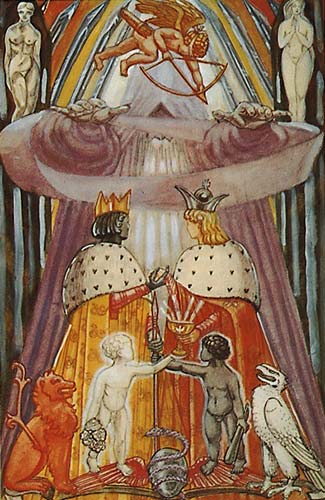
(Gemini, Zain)
The Lovers represent the alchemical union of opposites, a card rich with symbolism of choice, harmony, and divine love. Associated with Zain, the sword, this card represents the piercing clarity needed to discern and unite polarities. Gemini, the zodiac of duality and communication, imbues it with the energy of connection and synthesis.
The Thoth Lovers card depicts the union of the royal figures of Sol and Luna under the guidance of a cupid-like angel. Below them, the Orphic egg is encircled by the serpent, symbolising potential and cosmic rebirth. The figures are surrounded by the emblems of alchemical transformation: fire and water, masculine and feminine, light and shadow. The imagery suggests not only romantic love but also the integration of the conscious and unconscious mind, as in shadow work.
In Relationships: The Lovers signify connection, mutual respect, and the merging of hearts and minds. It also emphasises the importance of choice and the conscious commitment to love and partnership.
In Work: This card suggests collaboration and harmonising diverse forces to achieve a greater goal. It encourages you to seek partnerships that align with your values and vision.
Spiritually: The Lovers represent the union of opposites within the self, a crucial step on the path to enlightenment. It calls you to embrace your inner dualities and find harmony through integration.
When ill-dignified: The Lovers caution against indecision, misaligned partnerships, or superficial connections. You are urged to examine whether you are avoiding responsibility or compromising your truth for the sake of harmony.
Karma
These cards represent the influences of karma and destiny that are beyond your control. They suggest adapting to this fate.
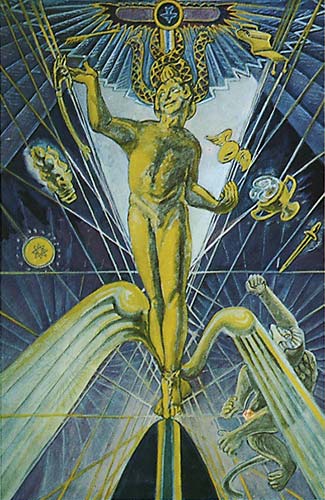
(Mercury, Beth)
The Magus of the Thoth deck radiates dynamic energy, the force of will and intellect that shapes reality. He corresponds to Beth, the house, signifying the power to create structure and form. Governed by Mercury, the Magus represents the mastery of communication, skill, and adaptation, embodying the ability to transmute thought into action.
The Magus stands amidst the elements he commands. Around him swirls the wand, cup, sword, and disk, each imbued with vibrant, electric energy. His figure exudes movement and control, as though he exists in a state of constant creation. Above him, the winged caduceus—the rod of Hermes—rises as a symbol of unity and transformation. The beam connecting heaven and earth signifies the infinite cycle of energy and potential.
In Relationships: The Magus suggests magnetic attraction and the ability to manifest deep, meaningful connections. It emphasises the importance of clear communication and aligning intentions with actions to nurture relationships.
In Work: This card signifies mastery and the ability to manifest success through focus and skill. It advises you to harness your talents and act with precision and intention to achieve your goals.
Spiritually: The Magus represents the awakening of personal power and the alignment of the microcosm and macrocosm. It is a call to take responsibility as a conscious creator in the divine play of existence.
When ill-dignified: The Magus warns of manipulation, overconfidence, or a scattering of energy. You are urged to examine your motives and ensure your actions serve the highest purpose, avoiding the temptation to misuse your gifts.
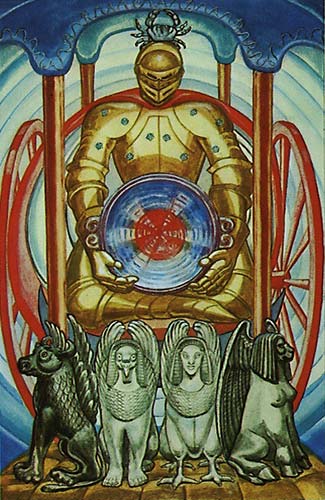
(Cancer, Cheth)
The Chariot represents triumph through willpower, discipline, and the unification of opposing forces. Associated with Cheth, the fence, it symbolises both protection and the boundaries that define and direct progress. Cancer, the zodiac sign of emotional depth and intuition lends the card its nurturing energy, ensuring that strength is tempered with compassion.
The Charioteer is a figure of regal composure, encased in golden armour and standing within a shell-like chariot. This shell evokes the protective qualities of Cancer, while the armour signifies spiritual and emotional fortitude. In his hands, he holds the Holy Grail, a symbol of divine purpose and spiritual attainment. The four sphinxes that draw the chariot—two white and two dark—represent the dual forces of light and darkness, which the Charioteer must master to move forward. The canopy above him is adorned with stars, linking his journey to celestial guidance and higher aspirations.
In Relationships: The Chariot indicates a relationship that requires balance and mutual effort to succeed. It suggests overcoming obstacles through shared determination and a focus on common goals.
In Work: This card signifies victory achieved through discipline, focus, and the ability to steer conflicting forces towards a unified purpose. You are encouraged to remain steadfast and clear in your intentions.
Spiritually: The Chariot represents the journey of the soul towards higher awareness, guided by the alignment of will and intuition. It calls you to embrace your inner strength and move forward confidently.
When ill-dignified: The Chariot warns of a loss of direction, internal conflict, or reckless ambition. You are advised to reassess your goals and ensure you are not being led astray by conflicting desires or external pressures.
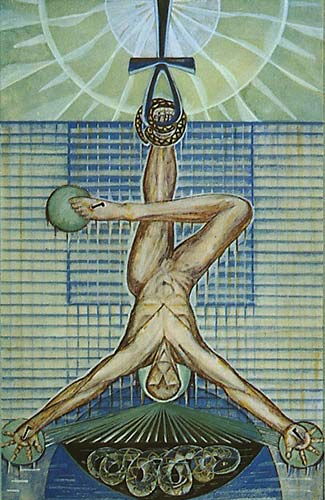
(Water, Mem)
The Hanged Man represents surrender, transformation, and the wisdom gained through self-sacrifice. Associated with Mem, the waters, this card embodies the flow of unconscious depths and the mysteries that lie beyond the material world. It is not a card of suffering but one of enlightenment through letting go.
The central figure is suspended upside-down, forming a cross with his legs, a symbol of balance and sacrifice. His arms form a triangle, evoking the union of spirit and matter. Behind him, the swirling blue-green background suggests the ocean of the subconscious. The serene expression on his face reflects the tranquillity found in surrendering to a greater truth. Around him, rays of light emanate, signifying the revelation that arises from this state of suspension.
In Relationships: The Hanged Man suggests a need for patience, selflessness, and understanding. It encourages you to see things from your partner's perspective and release control.
In Work: This card indicates a period of pause or sacrifice, where immediate goals may need to be set aside for long-term growth. You are advised to trust in the process and focus on the bigger picture.
Spiritually: The Hanged Man symbolises enlightenment achieved through surrender and the release of ego. It calls you to embrace the transformative power of stillness and contemplation.
When ill-dignified: The Hanged Man warns of stagnation, resistance to change, or clinging to outdated beliefs. You are advised to let go of what no longer serves you and embrace the wisdom of surrender.